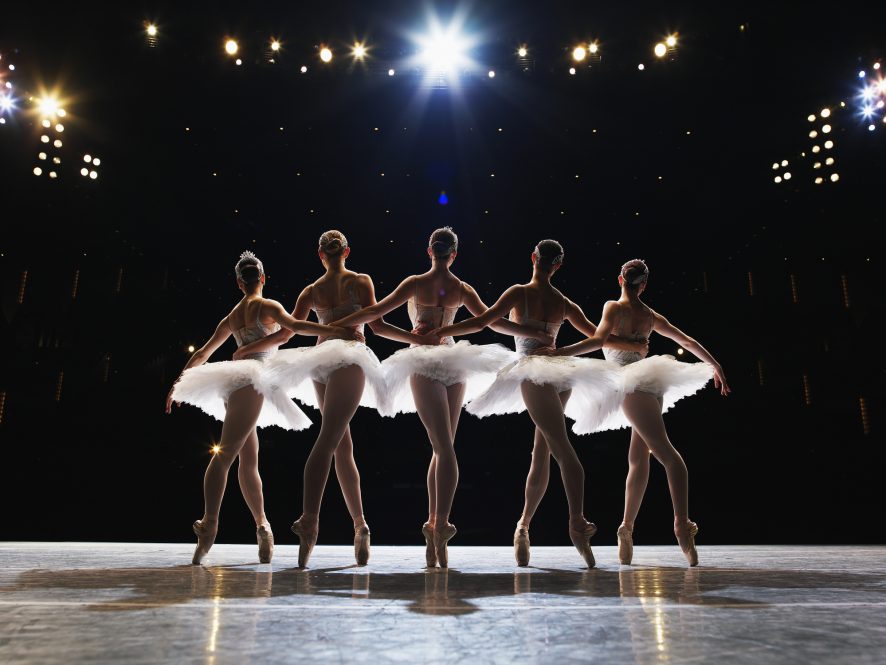From Clara in “The Nutcracker” to the nymphs in “Afternoon of a Faun,” a new study from UConn researchers is among the first to empirically document what many dance enthusiasts have known for some time: Audience members expect the ballerinas they see on stage to be white.
“The historical roots of ballet are Eurocentric, so it makes sense that we would see a lot of white ballerinas and not a lot of Black ballerinas,” study co-author and UConn Ph.D. candidate Sydney Klein says. “Despite many prominent dancers and choreographers like George Balanchine who were inspired by the modern dance that evolved out of traditionally Black communities, we still don’t have inclusivity in ballet.”
It’s a finding that wasn’t surprising to Klein and UConn’s Alaina Brenick, an associate professor in human development and family sciences, who together recently published “Dance in Black and White: Examining the Stereotypes of Black and White Ballerinas and Hip-Hop Dancers” in Women in Sport and Physical Activity Journal.
They expected the majority of the 268 people surveyed online – predominantly non-dancers, although a few identified themselves as dancers – to say ballerinas are white. They also expected those surveyed to say hip-hop dancers are Black.
“Hip-hop grew out of the Harlem Renaissance in traditionally Black and African American neighborhoods in New York City,” Klein says. “For me, though, what stands out is the overwhelming inclusivity and over-representation of white dancers in hip-hop, like in music videos and Super Bowl halftime shows, despite what those surveyed said. Many hip-hop dancers are white, yet in ballet there isn’t the same inclusivity.”
The study is a bit of a passion project for Klein, who conceived the idea around 2017 when she was an undergraduate at SUNY Geneseo and her advisor, Colin A. Zestcott, who now teaches at The College of St. Scholastica in Minnesota and is the third author on the paper, encouraged her to pursue the research.
Klein had been taking dance since she was 2 years old – the usual ballet, tap, and jazz – and was a dance minor at SUNY, where she dove into the history of dance and began to think about how to merge her interest in race studies and stereotypes with her longtime love of dance.
She thought that by answering definitively whether audiences expect dancers to have certain racial identities, she might be able to extrapolate whether that carries outside the dance world and advances the stereotypes of Black and white women in general – in dance, white women are seen as slim, delicate, and meek, according to the study, and Black women often are considered strong, aggressive, and loud.
“Now we can begin to understand the why. Why is it this way and how do these stereotypes and views of what dancers should be permeate other spaces in arts and entertainment and even everyday pockets of life,” she says.
Brenick, the daughter of a ballerina who studied dance through college and who herself took tap and ballet as a youngster, says the rise and popularity of Misty Copeland, the first Black principal dancer at American Ballet Theatre, about a decade ago didn’t much change the composition of students in studios and professionals on stage.
Copeland still is seen by many as the singular example of Black ballet dancers, Brenick says, and is treated as achieving a high level of success despite not fitting the white aesthetic and body type.
“This ignores a long history of other successful Black ballet dancers who were not and are not able to receive the same level of mainstream recognition,” she adds. “The nuance is that she isn’t alone in success or high achievement, at least outside of mainstream ballet, but she is often treated that way.”
The study says 62% of ballet degrees from U.S. universities offering such programs went to white dancers, with 20.5% going to Latine dancers, 5.13% to Asian dancers, and 2.56% to Black dancers.
“There are so many institutions within our society that are just steeped in systemic inequity and discrimination,” Brenick says. “This study is a critique of love. To love this discipline and to critique this discipline is to make it stronger, to make it more inclusive, to make it healthy, safe, and supportive for any dancer. We want to push the discipline forward so everyone can benefit from all the incredible opportunities that dance provides.”
Klein adds, “That sentiment of critiquing the spaces you love and enjoy, simply because you love and enjoy them and want everyone to love and enjoy them is what has carried me through my research. I think so much about the young kids who are in their dance classes and learning their ballet positions for the first time and the larger implications of these findings.”
Moving on from dance, she says she plans to continue looking at race in other informal spaces, like on television or in social media.
“This study has opened a line of research that will extend into my dissertation journey and that’s looking at how we understand the social implications of race and racial identity and how race is communicated in the informal learning spaces or the recreational spaces that we take up,” Klein says.
Brenick notes, “Sydney has followed this incredible developmental trajectory of looking at everyday spaces that we find ourselves in and how we make meaning of our social identity and how we can effectively engage in that critique process to create those inclusive and supportive environments, so we can all benefit from these everyday informal learning spaces.”



